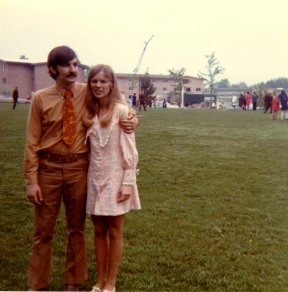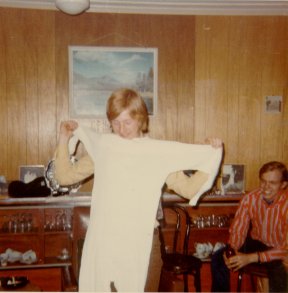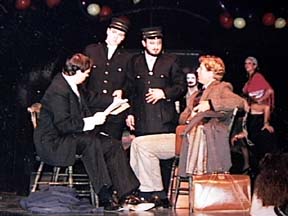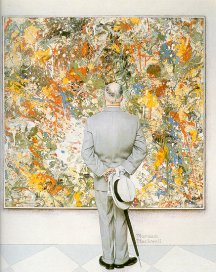Did Oswald Shoot Kennedy
No, of course not.
In 1978, Edward Jay Epstein published a book called “Legend: the Secret World of Lee Harvey Oswald.” He tries to show that Oswald had very suspicious ties to Soviet Russia and Cuba. He doesn’t quite go so far as to say that Russia or Cuba planned Kennedy’s assassination, but he clearly lays out the groundwork for such a conclusion.
The book was published by Reader’s Digest. If that doesn’t tell you enough about it (condensed books for condensed brains), then consider that Epstein has no problem with the “magic” bullet which supposedly went through Kennedy’s neck, John Connally’s ribs, wrist, and thigh, and emerged without a mark only to appear on the wrong stretcher in Parkland Hospital, so that it could be definitively “traced” to Oswald’s rifle. Nor does he tell you that the palm print taken from the rifle, which matched it “conclusively” to Oswald, was only “found” by the FBI after the Dallas police had already concluded that the rifle bore no finger prints at all. Nor does he mention that the bullets used to kill police officer Tippit were not, in fact, traced back to Oswald’s personal handgun and that, in fact, they could not have been fired from Oswald’s gun.
But, gee, those are just facts. There’s better material in “Legend”. The best part is Epstein’s nodding and winking as he describes Oswald’s suspicious behavior in New Orleans. What did Oswald do that was so suspicious? Well, he marched around handing out “Fair Play for Cuba” leaflets and appearing on radio stations.
Now, suppose for one minute that Oswald was, in fact, a Soviet or Cuban agent, sent to assassinate Kennedy in retaliation for the Bay of Pigs. Come on, you can do it. After all, he lived in Russia for several years and had a Russian wife. After all, he spoke fluent Russia.
So let’s say that some crazy day in 1960 or so, the KGB decided to shoot Kennedy. If you were a KGB officer, who would you choose to do the deed? Remember—if it is shown that you were behind the assassination, you would be in BIG trouble. For one thing, your own leaders would be fair game. For another thing, Cuba certainly would be invaded and re-colonized by the Americans. And of course, there was always the possibility of all-out war.
So who do you choose for this important task? Your cleverest, most experienced, most self-disciplined agent? Wrong. You choose an ex-marine defector with a Russian wife. You send him to America for a few years. You have him march around in New Orleans demonstrating and agitating on behalf of Castro’s Cuba. Then you send him down to Mexico to the Russian and Cuban embassies and have him loudly argue about getting a VISA to Cuba quickly because he can help the communists out by committing all kinds of violent crimes in the United States. You make sure the CIA gets all of this on their “hidden” cameras with the telephoto lenses.
Epstein is an idiot. His book is remarkable not because it defends the Warren Commission but because it simply pretends that none of the weird things about the Kennedy assassination even exist. In the thirty years since Kennedy’s death, most of the basic, confusing facts remain confusing. Part of the problem is that there are a lot of nut cases on both sides. But considered simply and directly, these facts certainly raise suspicions.
Oswald was a pretty smart guy who spoke fluent Russian, married a Russian woman, defected to Russia, defected back to the U.S., agitated for Cuba, tried to re-defect to Russia in October, 1963, worked at a map printing company that did secret work for the U.S. military, and sent a very, very strange note to a man named Hunt shortly before the assassination. He would have been a monumentally stupid choice for the Russians or Cubans to assassinate Kennedy.
Oswald is repeatedly described as having “fled” the scene. If he had been trying to escape Dallas, he could have gotten into a taxi at any time and driven off. Instead, he went home, and then to a movie theatre. He retrieved a pistol on the way. Think about these actions. If you had just shot the President of the United States from the building you worked in, would you go back to your home?
Witnesses to the Tippit shooting persistently denied that the man they saw was Oswald. Yet the FBI and the Dallas police continue to insist that the man they saw was, indeed, Oswald. Witnesses reported being harassed by investigators when they did not report the “correct” version of Tippit’s shooting.
Epstein believes that the problem with the magic bullet is easily solved. He simply decides that Oswald started firing sooner, while Kennedy was still out of view. Even the Warren Commission couldn’t be so bold, because the Zapruder film shows rather definitively that Oswald did not fire before the limousine drew behind the freeway sign.
The pristine bullet cannot have been the same bullet that shattered Connally’s wrists and ribs. It simply can’t. It was planted on the stretcher in the Dallas hospital (the wrong one, apparently) to implicate Oswald.
Oswald was spotted drinking a coke and having his lunch about 40 seconds after the last shots were fired. It is barely possible for a man running full speed to make the distance from the sixth floor window to the 2nd floor lunch room in that time. But according to several witnesses, including a police officer, Oswald looked cool, calm, and quiet, as if he’d been standing there for some time.
No fingerprints were found on the rifle at all. The FBI, much later, claimed to have found a palm print on the stock, underneath the barrel. This was after the Dallas police had already stated publicly that there was no fingerprints on the weapon. So Oswald wiped the gun clean of prints and made it down to the cafeteria in 40 seconds?
Shortly after the shooting, the police asked the manager of the warehouse for a list of all missing employees. We are told that it was found that only one employee was missing: Lee Harvey Oswald. In fact, several employees were missing, but the police announced that they were searching only for Oswald.
The police obtained Oswald’s address from the Depository and broadcast it to all the police officers in the vicinity. The trouble is, this address, Elsbeth St., had been Oswald’s address six months earlier, before he began to work at the Book Depository. The address he had given to the Book Depository, and which was recorded in his employee file, was different. Where then, did the police really obtain this address from?
Jack Ruby was able to walk through a large group of police officers right into the basement of the police station, precisely at the moment that Oswald was emerging from the cell area, and shoot him precisely where underworld assassins shoot someone they really want to kill efficiently: in the stomach, the vital organs. By doing so, he ensured that no trial would take place, during which the evidence, and Oswald’s links to the intelligence services, would have been probed.
Just imagine a good defense attorney analyzing the Warren Commission’s single bullet theory, in court. Just imagine hearing all the witnesses testify that they heard shots and saw smoke coming from the grassy knoll. Just imagine a thorough dissection of the planning of the parade route, the actions of Roy Kellerman or William Grier – the slow-footed driver of the limo—and the rest of the secret service agents who had been up late the previous night partying. Imagine a thorough discussion of how and why Oswald obtained a job printing spy photographs considered top secret by the U.S. military just months before the assassination. If Oswald was a “lone nut”, he was the most well-connected lone nut in history. Imagine parading the Parkland doctors up to the stand to testify, as they did to the media immediately after the shooting, that the fatal bullet entered Kennedy’s forehead, not the back of the head, and that the throat wound was one of entry, not exit. Imagine a Grand Jury digesting the fact that the Parkland doctors were all deeply experienced with gunshot wounds, while J. Humes, the autopsy surgeon, had almost no experience in that area. Imagine how quickly a defense lawyer would have noticed that the frames of the Zapruder film, reproduced in Life Magazine, and in the Warren Commission Report, had been placed out of order, so that, coincidentally, they appeared to show Kennedy’s head snapping forward with the fatal shot, rather than backwards as it really did. Image a cross-examination on the question of why no finger-prints were found on the rifle, though Oswald could not have had enough time to wipe them off and run down to the second floor cafeteria on time to be spotted and questioned by a police man 40 seconds after the last shots were fired.
The lead attorneys for the Warren Commission, relying primarily on evidence supplied to them by the FBI, consistently ignored, degraded, or ridiculed any evidence that did not fit the preconceived “lone nut” and “single-bullet” theories of the assassination. The Commission report is riddled with omissions and inconsistencies, but the most glaring problem is the way eyewitness testimony is presented as reliable and demonstrative when it supports the Commission’s conclusions, and then ridiculed as unreliable and conjectural whenever it does not. Witnesses who saw a single gunman in the sixth floor window are triumphantly presented as damning proof of Oswald’s guilt. But other witnesses saw shooting from behind the grassy knoll, and saw bullets hit the curb (which would have meant more than three shots were fired) and saw a second man in the same window. In other words, the Commission’s only standard of truth was that which corresponded to its preferred theory of how and why the assassination took place. It was not an investigation at all. It was a rubber stamp. As a result, even people who believe the Commission’s conclusions do not bother defending the Commission report itself.
Top cabinet officials were on a plane bound for Japan at the moment of the assassination. White House communications were cut shortly afterwards. Neither of these two elements by themselves are suspicious, but, taken together with the other facts, they are positively eerie.
After years of reading just about everything there is to read about the Kennedy assassination, I’ve come to the conclusion that there are a lot of nuts out there who derive perverse satisfaction in proving to themselves that everyone, from the CIA to the KGB to the Mafia were all involved in Kennedy’s assassination. Possibly the worst expression of that view would be Oliver Stone’s movie hodgepodge, “JFK”, which combined every theory from the lunatic fringe into one incoherent, rambling, and chaotic film.
David Lifton, in “Best Evidence”, tackled the autopsy itself, at Bethesda Naval Hospital, and suggests that a brilliant team of conspirators managed to alter the body between Dallas and Washington, so that it appeared as if Kennedy was struck from behind. He goes too far. His mistake is that he believes that the conspirators were capable of such meticulous and foolproof planning. I don’t think the conspirators would have had any way of guaranteeing themselves access to the body for a sufficient length of time to accomplish the deed. It’s too preposterous. But he also believes that the body was “altered” to show that shots had come from behind. There’s no need to grasp at straws here—the existing autopsy report is riddled with inconsistencies.
The truth is that Lee Harvey Oswald, displaying not the slightest inclination for leftist politics, joined the marines. While he was with the marines, he was probably recruited by one of the U.S. intelligence services. He was trained in the Russian language. He began to publicly criticize capitalism and the American government in a way that seems utterly bizarre and ostentatious, unless, again, you assume there is some covert reason for him to make himself known as a communist. Then he “defected” to Russia. He tried to convince the Russians that he had information about spy planes to sell them. The Russians smartly realized that he was a plant and ignored him, even after he married a Russian woman named Marina. Having failed in this subterfuge, the American intelligence agency pulled him out by having him “renounce” his “defection”.
Back in the U.S., Oswald, who probably only married Marina as part of his cover, lived alone, and did a lot of strange things. He demonstrated on behalf of Cuba, but also tried to join a Cuban anticommunist organization. His office was in the same building and adjacent to an office used by men with direct links to U.S. intelligence agencies, including Guy Bannister. He had regular contacts with the FBI and other U.S. federal government agencies. (After he was arrested for distributing leaflets, and FBI agent came to see him and spent more than an hour talking to him in jail.) He briefly worked for a coffee company in New Orleans that would later sent a raft full of employees to NASA!
It should be noted that Marina did not tell the Warren Commission what it wanted to hear, until months after the assassination, after intensive questioning by the FBI, the Dallas Police, and other government agents. Members of the Warren Commission thought she was lying, because her story varied so much from the initial interviews. Their mistake was that they assumed she had lied in the beginning, and not after months of police harassment. Oswald’s mother, Marguerite, insisted that her son had been working for the government. She too was coached by the investigators until she, sort of, got the story right.
Then, in Dallas, Oswald worked for a printing company that received contracts from U.S. military intelligence, printing photos taken by spy planes. He offered to kill Castro for the U.S., and then offered to commit terrorist acts for Cuba. And so on, and so on. None of these activities make any sense unless you believe that Oswald was working for U.S. intelligence and the general plan was to have him infiltrate communist organizations or governments, and that when these plans failed, they periodically came up with other tasks for him, the purpose of which he himself probably barely understood. Shortly before the assassination, he sent a plaintiff note to a Mr. “Hunt”, begging for an opportunity to discuss his “situation”.
Then the purpose becomes clear. Think about it. If a real “lone nut” had shot Kennedy, and escaped, the entire nation would have turned every stone searching for him. There would have been a huge investigation. There would have been powerful suspicions. There would have been grave questions about the changes in policy Johnson introduced—especially towards Viet Nam. Perhaps the Secret Service would actually have been require to fire their incompetent agents, including William Grier who, upon hearing shots fired, put on the brakes!
There might have been an inquest, a trial, deeper investigations by a Grand Jury. If the slightest substantiated suspicion had fallen upon Naval Intelligence or the FBI or the Secret Service, the political dynamic of the entire decade would have changed. People would have demanded that someone “clean up” the government agencies suspected of involvement.
The best way to dissipate such suspicions is, of course, to throw suspicion elsewhere, and to convince the public that a single “lone nut” committed the crime. Now remember, you have to think about how it was planned, now how it actually turned out. In my view, the assassination was actually botched, and came out far messier than the conspirators had planned. The Zapruder film, for example, caused grave complications, for it provided a precise time-line of the sequence of shots.
In any case, the plan was for Oswald to be positioned where he could be made the patsy. Perhaps he had been ordered to guard the sixth floor of the Depository on the day of Kennedy’s trip. Oswald had already begun to realize he was being set up, but had no idea of what for.
If Oswald was indeed employed by the U.S. intelligence community, it would not have been difficult for the conspirators to position him in the building, direct suspicion towards him, supply the police with incriminating evidence, and arrange for him to be shot while “resisting arrest”.
The real shooter is on the sixth floor, but there is also quite likely someone behind the picket fence on the grassy knoll. They fire roughly at the same time, when Kennedy is in the best position for the shot from the grassy knoll, the best possible location for a fatal shot. The shooter in the Depository escapes in a Nash Rambler, as several witnesses suggested, while protected by numerous other agents. The shooter behind the picket fence disposes of his weapon and then joins a group of “hoboes” in a nearby railway car. Other conspirators, identifying themselves as FBI agents or Secret Service agents, prevent witnesses and police from following him quickly enough to identify the suspect, but witnesses from the the overpass see the puffs of smoke and locate the source of the shots, and find cigarette butts and footprints behind the fence.
Oswald’s background as a communist defector is ideal. The police and FBI—who despise Kennedy– immediately understand that the U.S. government will not want to go to war with the Soviet Union, so they downplay Oswald’s communism and play up the “lone nut” theory. So the conspirators correctly surmised that they could have their cake and eat it too. Top government officials could suspect that the Soviet Union was actually involve, while conveniently ignoring the implications and tacitly approving the Warren Commission’s conclusions.
The Warren Commission wishes only to placate an anxious electorate. It is clear from the notes and minutes of their meetings that nobody on the commission had a serious interest in uncovering any new facts. Nobody seriously wanted to suggest, at any time, that a conspiracy exists. Failing to kill Oswald at the movie theatre—too many police officers and witnesses around, probably—the conspirators arrange for Jack Ruby to burst into the Dallas police station at the exact moment Oswald is being moved. Ruby himself dies of cancer four years later after alluding to dark plots and explosive revelations.
My suspicion is that the FBI was not directly involved but it was well-known that Hoover hated Kennedy and liked Johnson—he was frequent dinner guest at Senator Johnson’s home in the 1950’s—so the FBI could be counted on to cooperate. In January, 1964, Johnson appointed Hoover head of the FBI for life, in spite of the fact that he was beyond the age of compulsory retirement. This was Hoover’s fondest wish. Reporters who knew Johnson well were astonished. They had understood that Johnson knew that Hoover was a dangerous, excessively powerful bureaucrat. Why would he extend his term?
The effects of Kennedy’s assassination are, of course, illuminating.
- The Viet Nam war continued, as Johnson rescinded Kennedy’s decision to withdraw.
- The military-industrial complex grew much, much bigger and richer.
- A conservative Democrat replaced a liberal Democrat.
- The CIA, which Bobby Kennedy had been trying to control, was given a free-hand to continue it’s sponsorship of various coups and insurgencies around the world.
- The cold war grew more intense.
- The oil companies (including several owned by the powerful Hunt family) grew rich.
Does it seem all that unlikely that the assassinations of King and Robert Kennedy were also part of a continuing strategy to maintain real control of the U.S. government?
Richard Nixon, who was in Dallas on the day of the assassination, may have benefited the most from Kennedy’s death. He eventually became President himself, of course. But I doubt he was a conscious part of the conspiracy. In fact, there is a lot of evidence to suggest that Nixon later on tried to take on the same elements of the intelligence community that conspired to assassinate Kennedy, and lost, big time. Except that this time, instead of having his brains blown out, he was impeached, and Gerald Ford, who sat on the Warren Commission (yes, he did!), became President. Since then, it’s been Carter, Reagan, Bush, and Clinton. Carter and Clinton, like Johnson, are conservative Democrats. Reagan and Bush are Republican. There has not been a “liberal” president since Kennedy, and Kennedy was a moderate liberal at best. Johnson was a liberal on domestic social policy, but an unregenerate hawk on the war in Viet Nam, and military policy.
I believe the conspirators grew wiser, and, noting the continued obsession with John Kennedy’s assassination, realized that their goals could be achieved with less risk, by simply destroying, politically, those it believed were a genuine threat to their control, and buying off the rest. The result is a striking trend in the U.S. economy that shows wages for the average work as completely stagnant for the past twenty years, while over-all wealth has increased by an incomprehensible margin.
The long-term result of Kennedy’s death is what we live with today. This bizarre infatuation with huge, expensive weapons, by governments that declare that they are obsessed with reducing taxes. The inability of either party to nominate a genuine outsider for the office of President. The vastly overblown Lewinsky scandal. Colin Powell. Large, expensive military bases that remain open though they have no military purpose. Congress voting budget increases to the Pentagon that the Pentagon did not request. All very strange.










 painting.
painting.